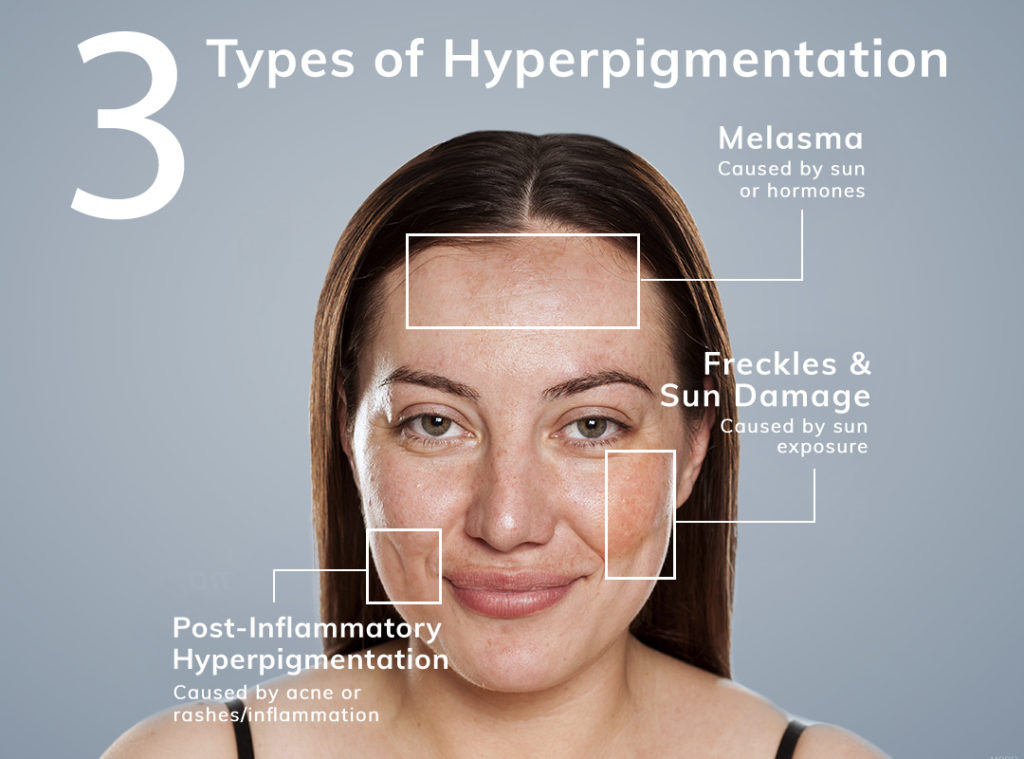One of the most commonly asked questions from our patients is about discoloration of the skin. From freckles and sun damage, to dark spots after acne or rashes, to discoloration from hormones or pregnancy, hyperpigmentation comes in many forms, and we address it all at DermPhysicians of New England.
In this month’s blog, we will cover some of the most common types of hyperpigmentation and how they can be treated.
What is Hyperpigmentation?
Hyperpigmentation occurs when melanin, the skin’s pigment or color, is overproduced in certain spots on the skin, causing discoloration or darkening of the skin.
Common Causes of Pigmentation
- Overexposure to the sun (#1!!!)
- Hormones from birth control pills or IUDs
- Hormones during pregnancy
- Medications
- Rashes such as eczema that cause inflammation in the skin
- Acne or picking at your acne
- Scratching chronically at your skin
Types of Hyperpigmentation

Melasma
- Brownish patches usually on the upper forehead, upper cheeks, and/or upper lip areas.
- Caused by sun, birth control hormones, or pregnancy
- Worsened by sun VERY easily
Post-inflammatory Hyperpigmentation
- Discolored spots (reddish or brownish) leftover from acne, a scratch, bug bite, or a rash.
Sun Spots & Freckles
- Brown spots from the sun
- Only appear in areas that have had sun exposure
- Darken over time with more sun exposure
Treatments
While you can treat or at least improve hyperpigmentation in many cases, it is not always possible. Pigmentation is complicated and occurs deep within the skin so it can be very difficult to treat, especially if present for a very long time. Success of treatment is based on an individual’s skin type, tolerance and how dedicated they are to protecting the areas from the sun.
The sun is not only one of the most common causes of hyperpigmentation of all forms, it is also the main reason it stays and returns. Without a VERY strict sun protection routine, hyperpigmentation is unlikely to improve and is VERY likely to return after any successful treatment.
The good news is that for those who are motivated to protect themselves from the sun, treatments can often help, and most of all, TIME is on your side. Hyperpigmentation of most forms, except sun spots, improves over the course of a year from the start of it, assuming hormones are not playing an ongoing role.
There are various topical ingredients that can help some forms of hyperpigmentation, especially melasma, including prescription hydroquinone, retinol, glycolic and Kojic acid. Topicals need to be used carefully and properly to work and not cause harm. Discontinuing or changing hormones can often lead to improvement over time. Chemical peels done in a series in combination with a topical regimen at home can be very helpful for certain situations. And FRAXEL laser can effectively treat melasma, sun spots, acne hyperpigmentation in many cases. IPL (intense pulsed light) can lighten sun spots as well.
So there are options!! But it all starts with identifying the problem, removing any possible triggers, an excellent sun protection routine (probably better than you have- just sayin’), and we are here to help you with all of that! And if you feel like you have failed with something in the past, it definitely does not mean you won’t succeed with something different. Schedule a consultation if you are struggling with one of these issues!
